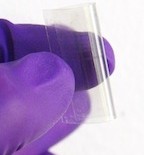Editor’s note: A link to a high-resolution image available for download is at the end of this release.
David Ruth
713-348-6327
Mike Williams
713-348-6728
Rice University professor reveals advance at American Chemical Society national meeting
HOUSTON — (March 27, 2012) — Want a see-through cellphone you can wrap around your wrist? Such a thing may be possible before long, according to Rice University chemist James Tour, whose lab has developed transparent, flexible memories using silicon oxide as the active component.
Tour revealed today in a talk at the national meeting and exposition of the American Chemical Society in San Diego that the new type of memory could combine with the likes of transparent electrodes developed at Rice for flexible touchscreens and transparent integrated circuits and batteries developed at other labs in recent years.
Details of the Rice breakthrough will be published in an upcoming paper, Tour said.
“Generally, you can’t see a bit of memory, because it’s too small,” said Tour, Rice’s T.T. and W.F. Chao Chair in Chemistry as well as a professor of mechanical engineering and materials science and of computer science. “But silicon itself is not transparent. If the density of the circuits is high enough, you’re going to see it.”
Rice’s transparent memory is based upon the 2010 discovery that pushing a strong charge through standard silicon oxide, an insulator widely used in electronics, forms channels of pure silicon crystals less than 5 nanometers wide. The initial voltage appears to strip oxygen atoms from the silicon oxide; lesser charges then repeatedly break and reconnect the circuit and turn it into nonvolatile memory. A smaller signal can be used to poll the memory state without altering it.
That discovery was reported on the front page of the New York Times. The Rice lab has since developed a working two-terminal memory device that can be stacked in a three-dimensional configuration and attached to a flexible substrate.
-30-
Professor Tour gave a press conference on transparent memory chips during the convention. View a video recording of the conference here: http://www.ustream.tv/recorded/21406611
Image for download:
A flexible, transparent memory chip created by researchers at Rice University. (Credit: Tour Lab/Rice University)
Located on a 300-acre forested campus in Houston, Rice University is consistently ranked among the nation’s top 20 universities by U.S. News & World Report. Rice has highly respected schools of Architecture, Business, Continuing Studies, Engineering, Humanities, Music, Natural Sciences and Social Sciences and is known for its “unconventional wisdom.” With 3,708 undergraduates and 2,374 graduate students, Rice’s undergraduate student-to-faculty ratio is 6-to-1. Its residential college system builds close-knit communities and lifelong friendships, just one reason why Rice has been ranked No. 1 for best quality of life multiple times by the Princeton Review and No. 4 for “best value” among private universities by Kiplinger’s Personal Finance. To read “What they’re saying about Rice,” go to http://www.rice.edu/nationalmedia/Rice.pdf.


